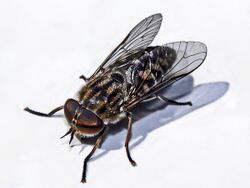Biology:Tabanus maculicornis
| Tabanus maculicornis | |
|---|---|

| |
| Tabanus maculicornis ♀ | |
| Scientific classification | |
| Domain: | Eukaryota |
| Kingdom: | Animalia |
| Phylum: | Arthropoda |
| Class: | Insecta |
| Order: | Diptera |
| Family: | Tabanidae |
| Subfamily: | Tabaninae |
| Tribe: | Tabanini |
| Genus: | Tabanus |
| Species: | T. maculicornis
|
| Binomial name | |
| Tabanus maculicornis Zetterstedt, 1842
| |
| Synonyms | |
| |
Tabanus maculicornis also known as the narrow-winged horsefly is a species of biting horse-fly.[2] File:Tabanus maculicornis (female).ogv[3]
Distribution
This species can be found in most of Europe, in the East Palearctic realm (Russia) and in the Near East (Transcaucasus).[4][5] It mainly lives in wooded areas with streams or in marshy grassland.[6]
Description
Tabanus maculicornis can reach a length of 12–13 millimetres (0.47–0.51 in). These quite small horseflies have a dark body. The abdomen of the females shows three rows of whitish or greyish triangles, with oblique sublateral markings on tergites 2 and 3. The head has a grey supraoccipital border. Females have scissor-like mouthparts that aim to cut the skin and then lap up the blood. The alula is narrower than in Tabanus bromius (hence the species common name). The eyes are green, but in males they show a broad purple band, while in females they have a coppery sheen and a single purple band.[6][7][8]
Biology
Adults fly flies from mid-May to mid-July, with a peak in late June. The females of this species are blood-sucking from grazing cattle (mainly cows and horses), but they mainly feed on nectar. They may also feed on human blood. Males only feed on nectar. Larvae live in boggy soil and in moss.[6][7]
Bibliography
- Kniepert, F.W. (1980). Blood-feeding and nectar-feeding in adult Tabanidae (Diptera). Oecologia 46, 125-129.
- Krčmar, S. & Leclercq, M. (1999). Horse flies (Tabanidae) a contribution to the knowledge about the biodiversity of Lonjsko Polje/. Bulletin S.R.B.E./K.B.V.E. 135, 209-213.
- Krčmar S. et al. (2005). Response of Tabanidae (Diptera) to natural and synthetic olfactory attractants. Journal of Vector Ecology 30(1), 133-136.
- Krčmar, S. & Maríc (2006). Analysis of the feeding sites for some horse flies (Diptera, Tabanidae) on a human in Croatia. Collegium Antropologicum. 30 (4), 901-904.
- Krčmar, S. (2007). Response of Tabanidae (Diptera) to canopy traps baited with 4-methylphenol, 3-isopropylphenol, and napthalene. Journal of Vector Ecology 31(2), 188-192.
- Oldroyd, H. (1939). Brachycera. In: F.W. Edwards et al. British blood-sucking flies. British Museum (Nat. Hist.), London.
References
- ↑ Egger, Johann (1859). "Dipterologische Beitrage". Verhandlungen der Kaiserlich-Königlichen Zoologisch-Botanischen Gesellschaft in Wien. 9: 387–407. https://www.biodiversitylibrary.org/item/55238#page/589/mode/1up. Retrieved 25 July 2021.
- ↑ Stubbs, A.; Drake, M. (2001). British Soldierflies and Their Allies: A Field Guide to the Larger British Brachycera. British Entomological & Natural History Society. pp. 512 pp. ISBN 1-899935-04-5.
- ↑ Chvála, Milan; Lyneborg, Leif; Moucha, Josef (1972). The Horse Flies of Europe (Diptera, Tabanidae). Copenhagen: Entomological Society of Copenhagen. pp. 598pp, 164figs. ISBN 978-09-00-84857-5.
- ↑ Catalogue of life
- ↑ Fauna europaea
- ↑ 6.0 6.1 6.2 Nature Spot
- ↑ 7.0 7.1 Influential Points
- ↑ M. Falck Key on The Horse Flies (Diptera, Tabanidae) of Norway
Wikidata ☰ Q1763625 entry
 |

